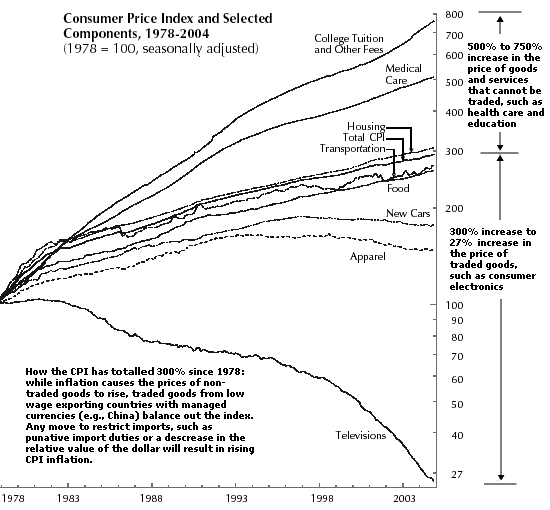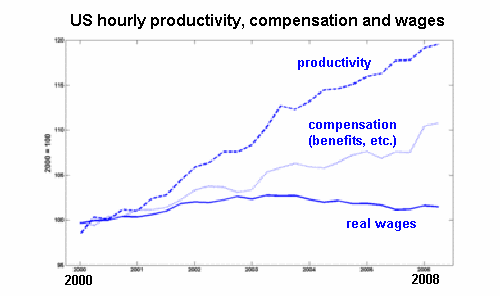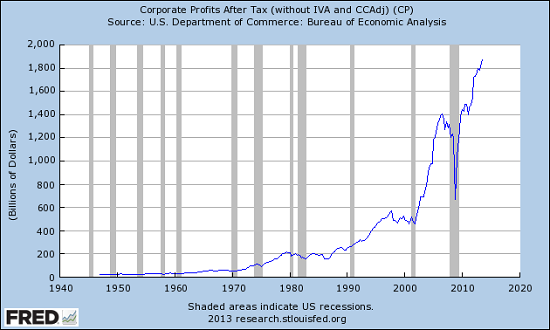There are four structural drivers behind the
soaring costs of the middle class lifestyle.
Why have the costs of a middle class
lifestyle soared while income has stagnated?Though it is tempting
to finger one ideologically convenient cause or another, there are
four structural causes to this long-term trend:
1. Baumol’s Cost Disease
2. Systemic headwinds to the current version
of capitalism
3. Dominance of global corporate capital
4. Financialization
The key take-away here is that the first two
causes are structural and cannot be changed by passing a law or
funding another state bureaucracy. Though many believe they
can tax global corporate capital to eliminate wealth inequality,
capital is mobile and will move to where it can expand. The dominance
of money in politics also means that the political machinery is for
sale to the highest bidder, which just so happens to be global
capital.
Since financialization rewards both capital and
the central state that depends on tax revenue, reversing
financialization politically is a non-starter.
No wonder the middle class is
evaporating. These trends are far more powerful than the
proposed solutions.
Let’s
start with Baumol’s
cost disease,
named after economist William J. Baumol, whose work with William G.
Bowen I described in Productivity,
Baumol’s Disease and the Cliff Just Ahead (December 8,
2010).
Baumol examined the relationship between
productivity and cost, and found that productivity in labor-intensive
services (for example, nursing and teaching) had intrinsically lower
rates of productivity increases than goods-producing industries.
The performing arts offers a striking example:
it takes the same time to learn and play a Mozart concerto now as it
did in 1790, so productivity gains will be modest.
This can be clearly seen in this chart of the
consumer price index, 1977-2005:

Note how manufactured goods such as TVs,
clothing and autos fell in price while education and healthcare
soared. Baumol foresaw the crunch that his theory predicted:
as healthcare and education took a larger share of the national
income/GDP, taxes would have to rise substantially to pay for those
services.
He
described the social choices we faced in a seminal 1993 paper: Health
care, education and the cost disease: A looming crisis for public
choice.
Baumol under-estimated the power of the
low-productivity sectors such as healthcare and higher education to
exploit political capture to increase their share of the national
income. In other words, the extraordinary rise in healthcare
and higher education costs arise not just from the low productivity
of these sectors, but from their cartel power to obscure the true
costs of their bloat and push prices higher.
Baumol also failed to appreciate how the
state (government) is the willing partner in this exploitation of low
productivity. The state enforces the monopoly pricing power
of these cartels. As a result, potential gains in productivity from
technology are suppressed to protect the cartels from any real
competition. (The same can be said of the military-industrial complex
and other state-protected cartels.)
That’s how we end up with college degrees and
medical procedures that cost more than a house.
The second set of systemic cost drivers were
identified by Immanuel Wallerstein, who views these forces as
threats to capitalism’s prime directive, which is to accumulate
more capital:
1. Urbanization, which increases the cost of
labor
2. Externalized costs (dumping private waste
into the Commons, environmental damage and depletion, etc.) are
finally having to be paid
3. Rising taxes as the Central State responds
to unlimited demands by citizens for more services (education,
healthcare, etc.) and economic security (pensions, welfare)
I
covered these headwinds to capitalism in Is
This the Terminal Phase of Global Capitalism 1.0? (February
8, 2013).
In brief, urbanization drives wages higher,
regardless of the era or economic system, and external costs such as
pollution and depletion must eventually be paid out of labor and
capital alike. The demand for more state services is unquenchable,
and the state responds by buying off key constituencies with more
benefits.
Wallerstein is one of the few who clearly
understands the State’s role as enabler and enforcer of monopolies
and cartels. High profit margins are most easily maintained
by persuading politicians to create/regulate quasi-monopolies and
cartels.
The State has two core mandates: enforce
quasi-monopolies and cartels for private capital, and satisfy enough
of the citizenry’s demands for more benefits to maintain social
stability.
If the State fails to maintain monopolistic
cartels, profit margins plummet and capital is unable to maintain its
spending on investment and labor. Simply put, the economy tanks as
profits, investment and growth all stagnate.
If the State fails to satisfy enough of the
citizenry’s demands, it risks social instability.
That is the nation-state’s quandary
everywhere. With growth slowing and parasitic cartels
increasingly difficult to maintain and justify, the State has less
tax income to fund its ever-expanding social spending.
In response, the State raises taxes and borrows
the difference between its spending and its revenues. This further
squeezes spending as the cost of servicing debt rises along with the
debt. The rising cost of debt service is an ever-tightening noose
that cannot be escaped.
Here are two charts: the first is
productivity, the second is corporate profits. Note that
while wages have stagnated, the cost of benefits (healthcare and
pensions) has absorbed much of the increase in productivity. The rest
has gone to corporate profits:


And this leads us straight to
financialization, the parasitic extraction of profits from the real
economy by finance and the state. Remember Wallerstein’s
key insight: the state depends on cartel pricing to sustain high
labor costs, investment and the taxes that flow from high wages and
profits. As the real economy stagnated, the state (which includes the
Federal Reserve) incentivized financialization and speculative credit
bubbles to keep the money flowing to feed its own spending.
In other words, the state isn’t just a
passive patsy in financialization–it is a willing partner, because
financialization funds the state. Just look at the enormous
expansion of property taxes and income taxes that flowed from the
housing and stock market bubbles.
Asking the state to limit financialization
is like asking the fox guarding the henhouse to stop eating plump
hens. If the fox stops consuming the plump hens, it dies. If
the state stops financialization, the state’s enormously expensive
programs and its debt machine all die, too.
In essence, the state has no choice: to save
itself, the middle class must be sacrificed.From the point of
view of global capital, the ideal partner is a powerful central state
that imposes cartel pricing on the economy: $200 million a piece F-35
fighter jets, $100,000 college diplomas, $200,000 medical procedures,
$1,000 a pill medications, etc.
From the point of view of the state, it’s
more important to protect corporate profits and preserve the ability
to borrow another trillion dollars at near-zero interest rates than
it is to restore a vibrant middle class.
Debt-serfdom works just fine for the
financial sector and the central state that enforces the
serfdom. Food stamps (bread) and distracting entertainment
(circuses) are cheap. What’s not to like about debt-serfdom to
those in power? Not only is it an ideal arrangement, it’s the only
one left to the state and its partner, global capital.
No comments:
Post a Comment